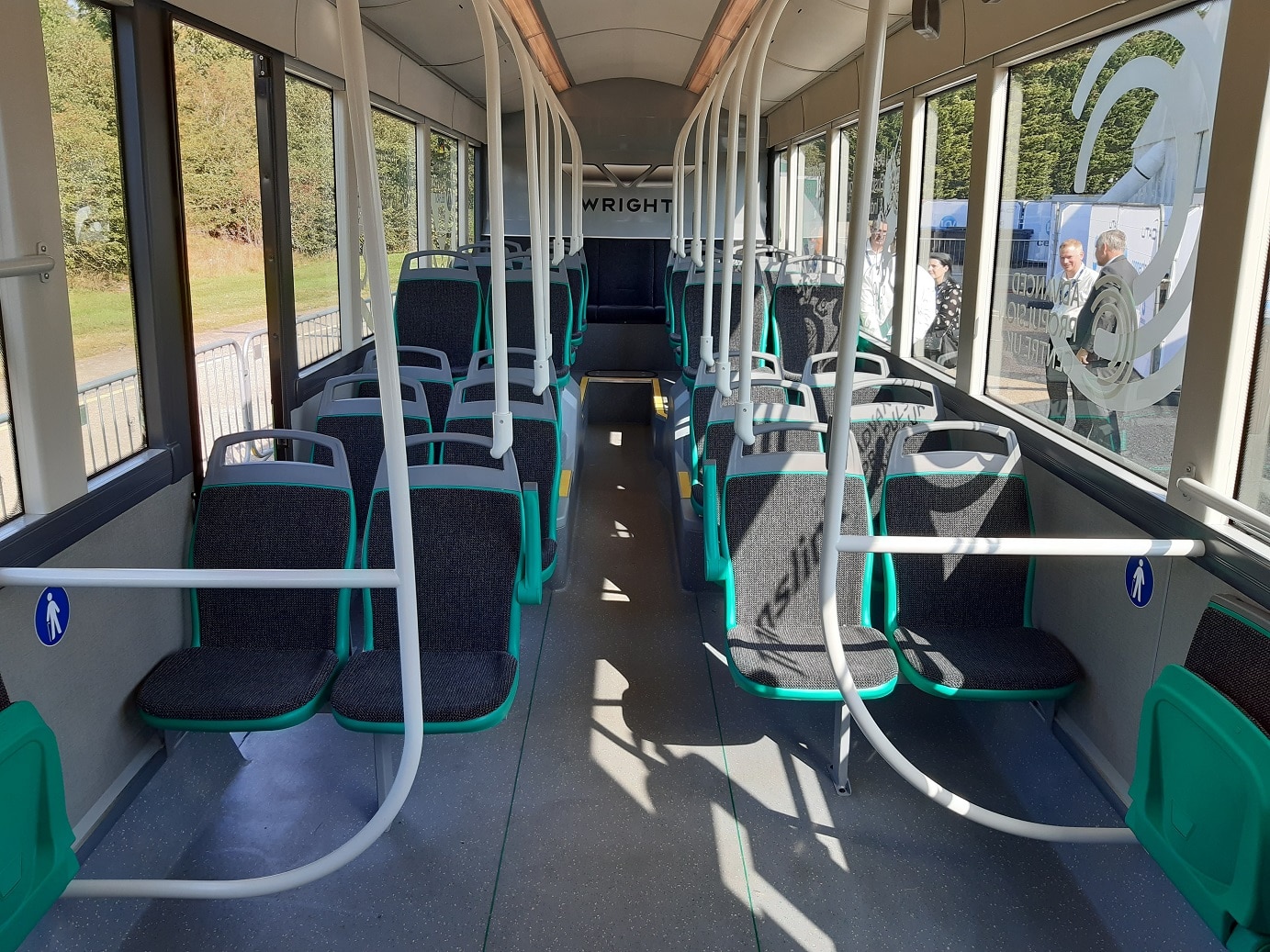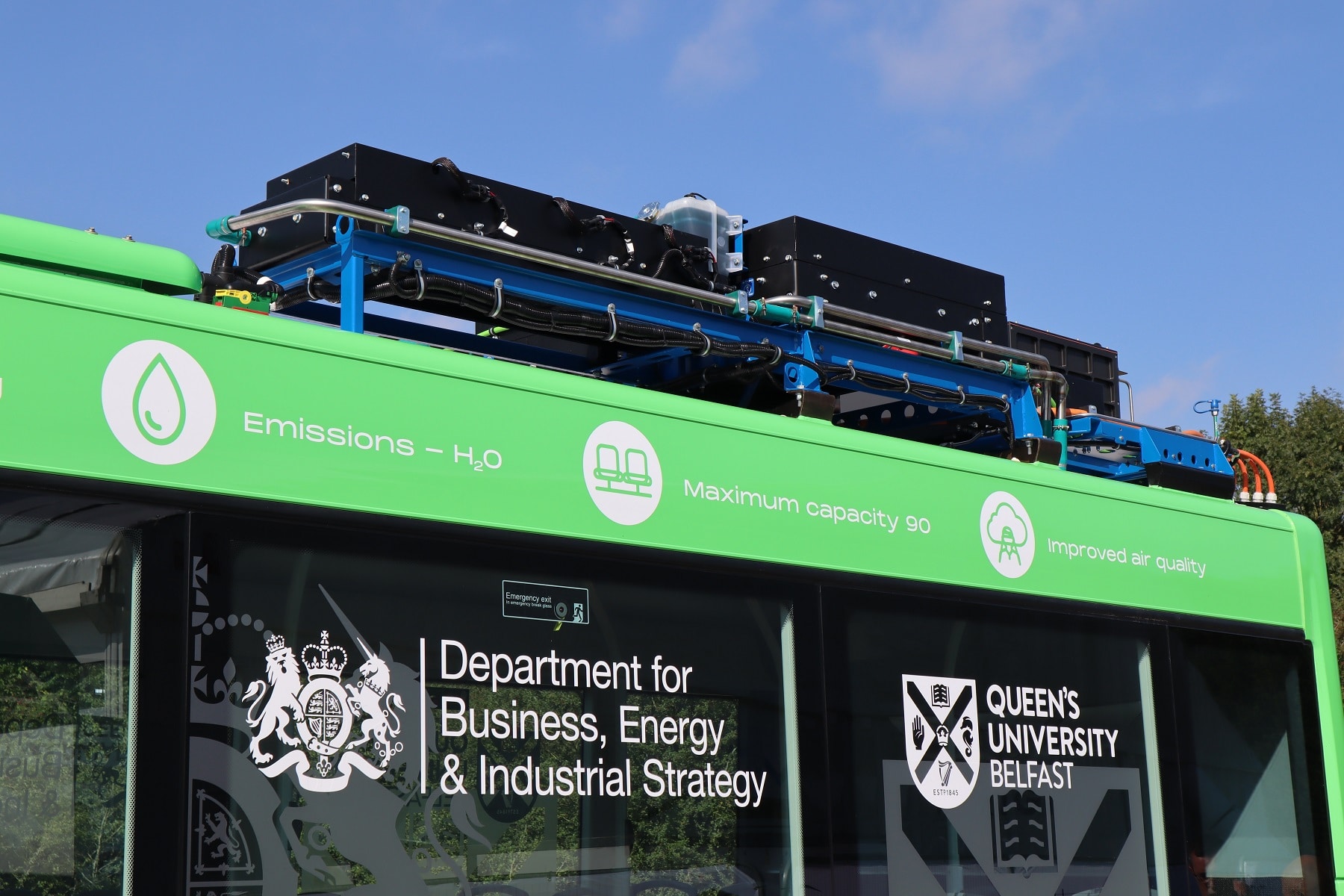Wrightbus reset the playing field for single-deck zero-emission bus range in September when it unveiled its modular GB Kite platform. Built first in hydrogen fuel cell-electric form and sharing the Hydroliner suffix with the StreetDeck double-decker that uses the same power source, it promises up to 640 miles between refills. Its battery-electric GB Kite Electroliner sister will deliver up to a claimed 300 miles between charges.
The new platform has been developed quickly. That is thanks to an award of funding through the Advanced Propulsion Centre’s Advanced Route to Market Demonstrator competition.
The initial GB Kite Hydroliner will serve as a mule, the manufacturer’s representatives said when it debuted at the Cenex-LCV event at UTAC Millbrook in September. At that time, a GB Kite Electroliner was yet to be constructed. But design work for it is complete. It will differ little from the Hydroliner up to the roofline, except for having scope for some batteries to be placed within the floor.
GB Kite platform: Designed for zero-emission from the ground up
The GB Kite has been designed specifically to suit both zero-emission energy sources, with modularity a key consideration. It will be available at 10.9, 11.6 and 12.4m lengths and it will be certified via the EC Whole Vehicle Type Approval process. Like its zero-emission StreetDeck sisters, the GB Kite has ZF axles with power delivered by the compact Voith Electrical Drive System.

Wrightbus has been pragmatic in how the motor is packaged. It is to the nearside behind the drive axle.
That position is with export markets in mind; while seats at the rear are on platforms to either side of a flat gangway, the raised area on the offside is a ‘dummy’, and there is nothing below it. Such an approach gives scope for a third door to be located there in left-hand drive applications.
In right-hand drive format, the GB Kite will be available in one- and two-door configuration. The roof is of sufficient strength to allow the Hydroliner’s fuel cell, batteries and hydrogen storage to be mounted there. As a result, there is little need for what would otherwise be an engine bay. Because of that, the rear five seats are hard to the back of the bus, maximising space utilisation.
Both the Electroliner and the Hydroliner will carry a maximum of 90 passengers. They each come with a GVW of 19,500kg
Ballard’s FCmove hydrogen fuel cell included on Hydroliner
The clever bits of the GB Kite Hydroliner are on the roof. Batteries are to the front of the bus, with the hydrogen tanks behind. The fuel cell sits beyond that.
Fitted to the mule vehicle are five hydrogen vessels. A seven-tank option will follow, and it will be required for the bus to achieve its headline 640-mile range. Hydrogen is stored at 350bar. However, Wrightbus will later offer a 700bar option. 700bar storage will potentially give a cost saving, says Director of Sales and Business Development John McLeister. As it is used in other parts of the automotive sector, economies of scale will be possible for some components.
A 70kW Ballard FCmove fuel cell is fitted to the first GB Kite Hydroliner. The recently launched 100kW variant of the FCmove will also be offered in production vehicles. John suggests that it will suit applications that involve higher speed running or where there is a heavy air-conditioning power draw; such an approach, he adds, will echo the split between four- and six-cylinder engines in some diesel buses.
In launching the 100kW member of its FCmove range, Ballard was keen to underline how its latest fuel cell line-up represents a significant advance over previous products. It describes the FCmove as “the most advanced fuel cell ever” that brings a major cost saving over its predecessors.
Telematics and rear-view cameras on GB Kite range

The GB Kite Hydroliner mule demonstrates Wrightbus’s new LCD dash binnacle, where dials are created digitally.
In addition, it has rear-view cameras, although the manufacturer will fit conventional mirrors if the customer requires.
Key to the Wrightbus zero-emission range is the WB Uptime 365 telematics platform. One of the elements that it delivers is “forward diagnostics,” which translates to predictive fault-finding to allow issues to be scheduled for rectification before they develop into a removal from service scenario.
GB Kite Electroliner to follow
Although development of the GB Kite Electroliner is following work on the Hydroliner, Wrightbus has released some data for the battery-electric single-decker. Internally, it promises to be identical to the hydrogen example thanks to the platform’s modular nature.
Three battery capacities, each using lithium NMC chemistry, will be offered on the Electroliner. The promised 300-mile range will come via 567kW/h of storage, while 454kW/h and 340kW/h will deliver claimed maximums of 240 and 180 miles, respectively.
Battery replenishment will be via either a CCS2 plug-in at a maximum of 150kW, or through pantograph-based opportunity charging at up to 450kW. An artist’s impression of the GB Kite Electroliner shows that the two models will be completed with streamlined roof cowling.
Wrightbus says it already has an order in hand for the GB Kite Hydroliner. The market for zero-emission buses becomes more competitive almost by the week, and as one operator has noted, the key for the Ballymena manufacturer now is to get more such product into the market and prove that it really can do what it says on the tin.



























